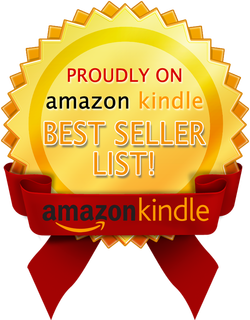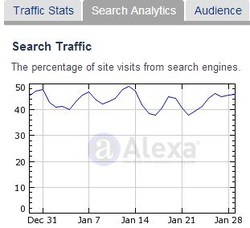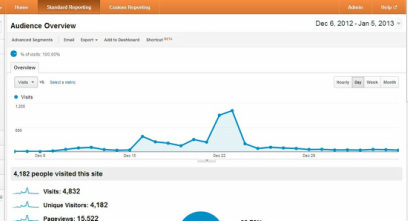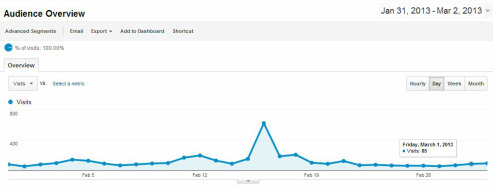Erica Verrillo's Blog, page 106
March 22, 2013
6 Sites Where You Can Get Fabulous Free Photos
Whether you are blogging, writing articles, or designing a cover for your book, there is nothing that attracts readers more than a fetching image. Eye-catching images not only draw the reader’s attention, they establish a mood, set a tone, and express what you can’t say in words. A great image will also inspire a reader to linger, and to want to learn more about you and what you have written.
Fortunately, finding beautiful images has never been easier – or cheaper. You can, of course, purchase stock photos from any number of services. However, if you are on a limited budget, you can now get great photos for free. These are some of my favorite sites for finding fantastic free images.
 1. Morguefile
1. Morguefile
Morguefile is my first stop when I am hunting for a photo. The quality is excellent, and you don’t need to jump through hoops to download. No registration is required. You are allowed to copy, distribute, transmit and adapt images. Attribution is not required. Like most other sources for free photos, Morguefile prohibits use of any photo in a stand alone manner. However, unlike other sites, you are free to use photos for commercial purposes (e.g. the cover of your book).
 Spilled Milk by Alecsandro Andrade de Melo 2. Stock.xchnge
Spilled Milk by Alecsandro Andrade de Melo 2. Stock.xchnge
Stock.xchnge, owned by Getty, has an enormous selection of good quality photos – 398,876 photos as of this morning. You can use all of their images for non-commercial purposes, but be sure to check the “restrictions” tab if you plan on using an image for a book cover or on anything else that you sell. Stock.xchnge also hosts a blog, tutorials and other perks for photographers. Be careful when searching! The top line of photos (and they are always gorgeous) are not free.
 © Jamie Wilson | Dreamstime Stock Photos 3. Dreamstime
© Jamie Wilson | Dreamstime Stock Photos 3. Dreamstime
Dreamstime has over 790,000 images. It’s a little harder to search than either Morguefile or Stock.xchnge, and registration is required. But once you figure out how to use this site, there are riches to be had. Attribution and a link back is required. The maximum number of copies allowed for free images is 10,000.
 4. Kozzi
4. Kozzi
Kozzi offers over 100,000 free photographs. Compared to Dreamstime, it’s easy to navigate. You have to register to use the site, but registration is free. One advantage of this site is that there are various size options for photographs. Commercial usage is allowed! (Check their FAQs.)
 5. Free Range Stock
5. Free Range Stock
Freerange has an eclectic mix of photos, from abstract paint spatters to squirrels. They post their newest photos on the first page, which makes for an interesting introduction to the site. You can search by category, and by most popular and newest. You must register to download. Commercial use is not allowed. Freerange shares revenue from ads on its site with photographers who submit their photos, which is a nice gesture. Alien Worlds by micromoth 6. RGB Free Stock Photos
Alien Worlds by micromoth 6. RGB Free Stock Photos
All images on RGB Stock Photos are free for personal and commercial use. (The terms of use for commercial purposes are that you only need to contact the artist for written permission.) Some of these photos are truly captivating. RGB also ranks its photographers, so you can search images by the most popular artists.
Fortunately, finding beautiful images has never been easier – or cheaper. You can, of course, purchase stock photos from any number of services. However, if you are on a limited budget, you can now get great photos for free. These are some of my favorite sites for finding fantastic free images.
 1. Morguefile
1. MorguefileMorguefile is my first stop when I am hunting for a photo. The quality is excellent, and you don’t need to jump through hoops to download. No registration is required. You are allowed to copy, distribute, transmit and adapt images. Attribution is not required. Like most other sources for free photos, Morguefile prohibits use of any photo in a stand alone manner. However, unlike other sites, you are free to use photos for commercial purposes (e.g. the cover of your book).
 Spilled Milk by Alecsandro Andrade de Melo 2. Stock.xchnge
Spilled Milk by Alecsandro Andrade de Melo 2. Stock.xchngeStock.xchnge, owned by Getty, has an enormous selection of good quality photos – 398,876 photos as of this morning. You can use all of their images for non-commercial purposes, but be sure to check the “restrictions” tab if you plan on using an image for a book cover or on anything else that you sell. Stock.xchnge also hosts a blog, tutorials and other perks for photographers. Be careful when searching! The top line of photos (and they are always gorgeous) are not free.
 © Jamie Wilson | Dreamstime Stock Photos 3. Dreamstime
© Jamie Wilson | Dreamstime Stock Photos 3. DreamstimeDreamstime has over 790,000 images. It’s a little harder to search than either Morguefile or Stock.xchnge, and registration is required. But once you figure out how to use this site, there are riches to be had. Attribution and a link back is required. The maximum number of copies allowed for free images is 10,000.
 4. Kozzi
4. KozziKozzi offers over 100,000 free photographs. Compared to Dreamstime, it’s easy to navigate. You have to register to use the site, but registration is free. One advantage of this site is that there are various size options for photographs. Commercial usage is allowed! (Check their FAQs.)
 5. Free Range Stock
5. Free Range StockFreerange has an eclectic mix of photos, from abstract paint spatters to squirrels. They post their newest photos on the first page, which makes for an interesting introduction to the site. You can search by category, and by most popular and newest. You must register to download. Commercial use is not allowed. Freerange shares revenue from ads on its site with photographers who submit their photos, which is a nice gesture.
 Alien Worlds by micromoth 6. RGB Free Stock Photos
Alien Worlds by micromoth 6. RGB Free Stock PhotosAll images on RGB Stock Photos are free for personal and commercial use. (The terms of use for commercial purposes are that you only need to contact the artist for written permission.) Some of these photos are truly captivating. RGB also ranks its photographers, so you can search images by the most popular artists.
Published on March 22, 2013 09:04
March 16, 2013
A simple way to sell more books ...
 "What makes someone decide to read a particular book? Do people read on their cell phones? Is there really a "walled garden" or do people shop around for e-books? And how many readers actually want books in serial format?" Goodreads has answers to all of these questions.
"What makes someone decide to read a particular book? Do people read on their cell phones? Is there really a "walled garden" or do people shop around for e-books? And how many readers actually want books in serial format?" Goodreads has answers to all of these questions.At the recent ‘Tools of Change’ publishing conference in New York, Goodreads CEO Otis Chandler revealed a remarkably simple, effortless way for authors to sell more eBooks on Amazon… or in fact anywhere eBooks are sold online.
In a survey of Goodreads’ 15 million strong membership, he found that the main driver of eBook purchases was, unsurprisingly, ‘referral by a friend’. But when a follow-up question was put to readers, another powerful sales strategy for authors emerged.
They were asked: “What do you want to do when you get to the end of a book?”
The telling response was this: 83% wanted to see what else the author had written.
The question is, how do you get readers to find your other work?
(The answer is so obvious, you're going to want to kick yourself.)
Go HERE for the answer - Jonathan Gunson's blog, "Goodreads CEO Reveals A Remarkably Easy Way To Sell More Books."
More information:
Read Otis Chandler's fascinating report on what makes people want to read a book, where they do it, and how.
Published on March 16, 2013 13:40
March 13, 2013
Rising in the Ranks: Amazon Sales Rank … What Does It Mean, and Why Should You Care?
 If you have recently published a book, you naturally want to keep tabs on how it is selling. Publishing houses will, of course, send you yearly or, for the larger houses, biannual royalty statements. That's a long wait for an impatient author. If you need instant gratification, your only real up-to-date source of information is Amazon. This is not only because Amazon is the only seller that will update your sales hourly – or daily, depending on the number of sales – it's because Amazon ranks its books. If you have aspirations of becoming a bestselling author, you will find yourself glued to your Amazon page within minutes of publication.
If you have recently published a book, you naturally want to keep tabs on how it is selling. Publishing houses will, of course, send you yearly or, for the larger houses, biannual royalty statements. That's a long wait for an impatient author. If you need instant gratification, your only real up-to-date source of information is Amazon. This is not only because Amazon is the only seller that will update your sales hourly – or daily, depending on the number of sales – it's because Amazon ranks its books. If you have aspirations of becoming a bestselling author, you will find yourself glued to your Amazon page within minutes of publication.Amazon's ranking system has been the source of much speculation over the years. The ranking is not only based on the number of books sold by the day (or hour), but also takes into account how your book fares against other books in the same category, which Amazon calculates based on a secret algorithm which only clairvoyants, psychics, and 33rd degree Masons have access to. (It is not for "simple folk" to understand the ways of Amazon, which makes them all the more intriguing.)
If you do a Google search on “Amazon ranking” you will find pages of articles written by frantic, OCD rankaholics who have tracked their sales hourly, compared them to their ranking, and graphed them. Dream on! Only those who have enrolled in KDP Select – an Amazon promotional program designed to kill Barnes & Noble once and for all – can actually track sales against ranking. And even those chosen few are not privy to the Ultimate Truth. Ranking changes hourly, but sales reporting may lag by a day.
We can never truly perceive reality...
State Your Name, Rank and Title
But you can get close to it. NovelRank is a free website that allows authors to track their ranking on Amazon.com (US), Amazon.co.uk (England), Amazon.ca (Canada), and Amazon.de (Germany). You can also check a box to include Amazon.fr (France), Amazon.it (Italy), Amazon.co.jp (Japan), Amazon.cn (China) and Amazon.es (Spain). (NovelRank warns you that checking the box may clutter your details page, but, hey, if Pandora didn't care, neither do we!)
And that's not all! You can get RSS feeds to get updates when a book is sold and to view your hourly sales rank. Now you can be obsessed everywhere! You can get graphs!
How to Quantify a Bestseller
In the end, all this watching and waiting pays off! If you never, ever take your eyes off your sales rank, you may become a bestselling author. That's when you have hit pay dirt. StoryFinds knows exactly, uh, almost exactly, how many book sales it takes to enter the ranks of bestsellers. (I have personally checked this chart against my own sales and found it to be accurate.) Here it is:
Bestsellers Rank 40,000 to 100,000 - selling close to 1 book a day.
Bestsellers Rank 8,500 to 40,000 - selling 1 to 10 books a day.
Bestsellers Rank 3,000 to 8,500 - selling 10 to 20 books a day.
Bestsellers Rank 1,500 to 3,000 - selling 20 to 40 books a day.
Bestsellers Rank 1,100 to 1,500 - selling 40 to 50 books a day.
Bestsellers Rank 900 to 1,100 – selling 50 to 65 books a day.
Bestsellers Rank 750 to 900 - selling 65 to 85 books a day.
Bestsellers Rank 350 to 750 - selling 85 to 175 books a day.
Bestsellers Rank 200 to 350 - selling 175 to 250 books a day.
Bestsellers Rank 100 to 200 - selling 250 to 300 books a day.
Bestsellers Rank 80 to 100 – selling 300 to 400 books a day.
Bestsellers Rank 70 to 80 – selling 400 to 500 books a day.
Bestsellers Rank 50 to 70 - selling 500 to 650 books a day.
Bestseller Rank of 45 to 50 - selling 650 to 700 books a day.
Bestseller Rank of 30 to 45 - selling 700 to 900 books a day.
Bestseller Rank of 20 to 30 – selling 900 to 1,300 books a day.
Bestseller Rank of 10 to 20 – selling 1,300 to 1,800 books a day.
Bestseller Rank of 3 to 8 - selling about 4,000+ books a day!
Becoming a Bestselling Author on Amazon
If you've looked at your rank and are now depressed because you're not even close to a bestseller, don't despair. Becoming a bestselling author is surprisingly easy. If you join KDP Select and – this is crucial, so pay attention – promote the heck out your book's free days, you can turn your book into a bestseller within a day. Amazon counts free downloads as sales (you won't get royalties, however, because your book is free). When I got 6,000+ downloads in a 24-hour period, my book got the coveted yellow bar. That's an indication of how many you would need, more or less, to get to #1.
Once your book has risen to the rank of bestseller, it will appear on various lists (“top 100,” “top 20”), in relevant categories, which will increase its exposure. There is a caveat, however. Your book won't stay in #1 position for long. But you can use even a brief sojourn in the #1 spot to market yourself as a bestselling author on Amazon when you promote your work. (Make sure to take a screen shot!) Once you've hit the mark (it only takes once), you will almost certainly continue to rise in the ranks.
(If you want to know more about how I made the #1 spot, read Anatomy of An Amazon Bestseller.)
Published on March 13, 2013 06:39
March 10, 2013
How Amazon Killed Barnes & Noble, and Why We Don't Care
 "I have many skills ..." First published on Blogcritics as "How Amazon Killed Barnes & Noble, and Why We Don't Care."
"I have many skills ..." First published on Blogcritics as "How Amazon Killed Barnes & Noble, and Why We Don't Care."The year was 2010. Stephen Riggio, then CEO of Barnes & Noble, heralded the company's entry into the epublishing world. In a breathless announcement, Riggio euphorically proclaimed that Barnes & Noble would top the 18% mark in e-books "overnight." Not to be outdone by his own enthusiasm, Riggio predicted that Barnes & Noble would earn better margins from e-books than print books. Its booksellers would become, in his words, "e-bookevangelists."
Beware of all enterprises that require new jargon.
Today, even as I write, Barnes & Noble is crashing and burning. According to CNET, the company's earnings slumped an astonishing 63 percent, from $150 million last year to $55.5 million this year. The culprit? Nook.
Over the last quarter, Barnes & Noble watched in horror as Nook sales, their e-book division, plummeted 26%, with losses of over $190 million. It was like watching Icarus fall out of the sky. Stephen Riggio's dream of “overnight” success was so far off the mark, one had to wonder if he was high when he made his announcement two years ago.
Riggio wasn't high. In fact, Nook is a great e-book reader. Anyone who has worked with Nook's .epub files can tell you they are infinitely better than the cumbersome .mobi files used by Amazon's Kindle. Epub files produce a nice, cleanly formatted page that looks just like a book. Mobi files look just like a mess. But, as every entrepreneur knows, better products do not necessarily lead to better sales. So, where did Barnes & Noble go wrong?
Where B&N went wrong
Barnes & Noble had a better product, a better reputation, and a farther reach than anyone else in the book selling business. The problem was that Riggio misjudged – very badly – how to handle the burgeoning business of self-publishing.
With the advent of epublishing, writers who could never hope to see their books in print could get their work to readers without the time-consuming, and usually fruitless, task of trying to snare an agent, followed by the even more frustraing job of trying to hook a publisher. With epublishing, writers could simply upload a file, set a price, and voila! Instant publication. What's more they could do it anywhere, any time. No deadlines, no delays. An equal draw was that writers who epublished could completely control their work. With the elimination of pesky editors who demanded “show don't tell” and required the proper use of apostrophes, everything that went on or between an e-book's cybercovers was entirely up to the writer. To add icing to the cake, writers who epublished got to keep 70-80% of their royalties. Compared to the measly 10% (and that was on a good day) meted out by print publishing houses, it was a no-brainer.
According to Bowker, there were 211,269 self-published titles released in 2012, up from 133,036 in 2010. This surge in self-publishing, owing in large part to e-books, represents not just people “living the dream,” but an enormous business opportunity for anyone with the ability to turn other people's dreams into their hard cash. Barnes & Noble, with its gentlemanly rules of conduct and brick-and-mortar mentality, simply had no concept of how to corner the market. Amazon did.
The coup de grâce - Amazon's KDP Select
Amazon has always enjoyed the top rank in online sales. If you want to buy a book, any book, chances are you'll find it on Amazon. The “beauty part” is that, unlike brick-and-mortar stores, Amazon has minimal stocking requirements. Anybody can sell a book. Amazon merely takes a percentage.
So, when e-books came along, Amazon was already familiar with the rules. Writers could put their e-books up for sale much as they did their used print books. Amazon would take a percentage, and, additionally, provide delivery. Barnes & Noble did the same thing, but the difference – and this is crucial – was that if you enrolled in Amazon's KDP (Kindle Direct Publishing) Select program, you got to give your book away. The catch: You couldn't put your book up for sale on any other site for a (renewable) 90-day period.
Writers quickly discovered that giving an e-book away for free was the fastest, cheapest, and easiest way to build a readership. For the popular genre writers, such as romance and mystery/crime, it was a dream come true. Books in popular genres could rack up 20,000 to 30,000 downloads in a single weekend. Numbers like those would not only be considered a wild success in the print publishing world, they would be virtually impossible. Publishers rarely promote first-time authors.
Cottage industries have sprung up around the KDP Select phenomenon. Numerous websites will not only post which Kindle books are free on any given day, but will review them, and even send daily free titles to your inbox. There is no denying the appeal of getting something for nothing.
For writers, and for Amazon, it is a win-win situation, because free days are fantastic promotional tools. Invariably, free days lead to increased sales. And for those writers who simply must hold their precious darlings in their hands, Amazon also provides print-on-demand. Amazon’s CreateSpace took first place in the self-publishing world last year with 57,602 new titles. Amazon is happy. Writers are happy. Customers are happy. Everybody is happy.
Except Barnes & Noble. Which is dead.
Published on March 10, 2013 11:58
March 7, 2013
How Writers Can Use Alexa to Build a Platform
 First published on Blogging Authors 3/4/13) as "How Writers Can Use Alexa to Build a Platform."
First published on Blogging Authors 3/4/13) as "How Writers Can Use Alexa to Build a Platform."Of the many ranking systems used to evaluate websites, Alexa, an analytics service owned by Amazon, is one of the most popular. In a nutshell, Alexa measures traffic to a website – the more visitors, the higher the rank. (Low numbers indicate a high rank. Number 1, the highest position, is occupied by Google.) Alexa provides data on 30 million websites, and has over 7 million visitors monthly.
How does Alexa gather website information?
Big Brother is not actually watching you. In order to retrieve information on how many people visit a site, Alexa provides a free toolbar. (See below.) Once installed, this toolbar monitors which websites a person visits. That part is fairly straighforward, but not altogther useful. Mere numbers don't give businesses enough information to tailor their marketing efforts, which is why Alexa also gathers data on demographics, such as age and income groups, sex, and region. For marketing purposes, knowing who visits your website, and from where, is crucial information.
There are some drawbacks to the system. The toolbar is most often used by techies, people who specialize in SEO and other analytics. It shouldn't come as much of a surprise that tech sites have higher ranking than sites that appeal to people who are more concerned with other types of content – such as literary work. Alexa can't measure the browsing habits of people who don't install the toolbar, which may account for why regional traffic in India is often much higher than the U.S. (India is a major source of website and internet technology.)
How can you make Alexa work for you?
If you have just launched a website, don't even think of trying to improve your Alexa ranking. No matter what you do, your rank is going to be abysmally low (your number will be in the multi-millions), and there is no amount of backlinking, blogging, or giveaways that will get you under 100,000, which is the cut-off point for viewing demographic statistics.
Instead of trying to improve your own ranking, you can use Alexa much in the same way other businesses do. (If you have published a book, in any form, you are a business.) Let's say you would like to increase your visibility as a writer (i.e. build your platform). If your blog isn't getting a lot of traffic, it makes sense to either guest blog or write articles for sites that get significantly more visitors than yours. The easiest way to research the most-trafficked sites for posting guest blogs and articles is by looking at their Alexa ranking. You can get a quick view by installing the toolbar, or you can go the website for more specific data.
I have used Alexa ranking to help decide where I guest blog. Whenever someone publishes an article on the top sites for books, articles or blogs on my topic, I immediately look up their Alexa ranking. If the rank is high (i.e. the number is under 100,000), I check to see who visits the site. If the site appeals to my demographic, I submit a guest blog or article. Chances are, the article will be accepted, because I'm submitting an article geared towards the needs of their market.
Writing requires time and effort. Make sure you get the most out of your labor by placing your work where it will work for you.
Resources:
Alexa
http://www.alexa.com/
This is where you go to search Alexa rankings. To install the toolbar, click on the tab "Toolbar." Installation takes a few seconds.
What is Alexa Ranking and Is It Worth Striving For?
http://www.demondemon.com/2012/06/05/what-is-alexa-rank-and-is-it-worth-striving-for/
This is a nice little article that spells out what Alexa is and does … and doesn't.
Published on March 07, 2013 04:10
March 4, 2013
Anatomy of an Amazon Bestseller
 The received wisdom of self-publishing is to place your book everywhere, and in all formats. I did that (mostly). And it didn’t work. This is why: Writers who finance their own work can’t possibly promote their books everywhere, and in all forms.
The received wisdom of self-publishing is to place your book everywhere, and in all formats. I did that (mostly). And it didn’t work. This is why: Writers who finance their own work can’t possibly promote their books everywhere, and in all forms.Book promotion is time-consuming enough as it is, but promoting a book to brick-and-mortar booksellers, libraries, organizations, and individuals all at the same time is impossible. If we blindly obeyed received wisdom, not only would writers have no time to write, we wouldn’t have time to breathe. That’s why we are drawn to publishing houses, with their lure of marketing departments.
The promotion dilemma is one which I tackled after publishing my first ebook. (It was not in print form, thank God.) Dutifully, I made it available to everyone. After three months of minimal sales, I jumped ship and enrolled in Amazon KDP Select.
For those who are not familiar with Amazon’s KDP Select program, it requires exclusive publication for 90 days (renewable). In short, you have to remove your ebook from all other sites that may be selling it. At first glance this seems to be contradictory. How can you sell more books with fewer suppliers? The answer to that question is promotion.
KDP Select allows authors to give their books away for up to five days in any 90-day period during which the book is enrolled. Giving away products is a proven technique for increasing visibility – and it works like a charm for books.
I enrolled my book in KDP Select in December, and I advertised my free days (the weekend right before Christmas) to organizations, individuals who had written reviews, bloggers, anybody who might be interested. That weekend 1500 people downloaded the book. Although I was quite pleased, I’d hoped for higher numbers. What I didn’t expect was the incredible surge in visitors to my new website. During those two days, two thousand people visited my website. This was a considerable improvement over my previous number of visitors, which was in the category of “less than 10.” The best part was that sales increased. People who missed the book’s free days simply bought it. (I’d priced the book at $2.99)

Determined to do better on my next free days, I advertised more heavily. This time I put the announcement on every Facebook page that might even be remotely connected to my subject. (I also started a Facebook page for my book, something I should have done much earlier.) Facebook chastised me, and then kicked me off for two weeks with dire warnings of permanent banishment, but not before I’d posted the free days on nearly 200 Facebook pages.
This round, there were over 1700 downloads. It was a modest gain. And to my disappointment, fewer people had visited my website. But the number of people visiting the website daily had increased by a factor of ten. And my book’s Facebook page had a reach of 3,000. Once again, there was an uptick in sales.
I only had one free day left, and I was pulling out all the stops to make this a big one. Starting two weeks prior to the event, I notified all the people I’d contacted on previous free days, and, in addition, I posted on every Facebook page that had not reported me as “spam.” (This was easy to do. I simply looked to see which of my previous posts were still there.) And because I now had over thirty 5-star reviews from previous free days, I could now advertise my free days on several Kindle promotion sites. (More on those later.)
On my remaining free day, there were 6,292 downloads (which is not bad for an obscure medical reference book). Following the previous trend, there were fewer visitors that day to my website than during other free days, but there was a corresponding increase in daily visitors. Interestingly, my blog readers suddenly jumped to several hundred a day. That month, the book sold more than double the copies of the previous month. It was #1 on the bestseller list for my category, and placed in the top 20 for the next larger category, all of which means more promotion. It was also on the top 100 list for free books. (Smack between one book displaying a brawny pirate kissing a damsel in distress and another featuring a brawny farmer kissing a damsel in straw.)
 What had happened was fame. With nearly 10,000 people who had my book in hand (metaphorically speaking) I was now known in the appropriate circles. I got a job offer to edit a newsletter, and requests to do webinars and give talks. In short, I now had a platform.
What had happened was fame. With nearly 10,000 people who had my book in hand (metaphorically speaking) I was now known in the appropriate circles. I got a job offer to edit a newsletter, and requests to do webinars and give talks. In short, I now had a platform. While this short trial of KDP Select has been successful, I will probably call it quits after another three-month run and follow received wisdom. There is a time and place for everything. And the time to hit all venues is after your name is out there.
While this short trial of KDP Select has been successful, I will probably call it quits after another three-month run and follow received wisdom. There is a time and place for everything. And the time to hit all venues is after your name is out there.
Published on March 04, 2013 12:05
February 22, 2013
Jane Kaufman's writing tips: Punctuation marks deserve to be used with respect
 By Jane Kaufman, The Republican February 22, 2013
By Jane Kaufman, The Republican February 22, 2013Like a great dance partner, punctuation adds rhythm, flow and spice to writing.
It allows the reader to glide through a piece of prose naturally. Poor punctuation bogs down a reader. It confuses and can deaden a lively experience: It grates on the soul.
Fixing common punctuation mistakes does not take a doctorate, although many might argue that the whole murky endeavor is best left to nerdy copyeditors and grammarians.
The rules of punctuation are complex. However, even without knowing them, it is possible to tell when a comma or period is needed by reading S-L-O-W-L-Y out loud with a great deal of expression.
Pick a favorite orator and imitate their delivery style while reading. Commas should be inserted in places where one breathes or feels hesitation mid-thought. As silly as it sounds, it helps.
How do writers know when they reach the end of a complete thought? When reading out loud, a writer’s voice will naturally drop down in volume and pitch at the end. At that point, it is best to stop and pencil in a period. The buck stops with a period. Periods are like traffic cops. They tell the reader to stop right here.
Commas can work like parentheses and dashes. They can work in pairs to offset a phrase that, while important, is unnecessary to the flow of the sentence. While each of these pairs of punctuation can work in the same way, each kind adds a different level of “volume.”
Dashes in pairs add a shout to a sentence. They – like hot peppers – are best used sparingly. That’s because readers don’t like to be yelled at.
Parentheses add a whisper (call it a secret) to a sentence. Yet, like dashes, they can grow tiresome, similar to the insistent tug of a child who wants to leave.
A pair of commas adds a nearly invisible aside, like this, to a sentence. Notice how transparent the commas are in that sentence. They interrupt quietly, without drawing attention to themselves or the phrase they contain. They’re polite, unassuming, like a genteel relative.
A second common use of the comma has to do with time-bound phrases called conditional, dependent or subordinate clauses.
If a sentence begins with the word “if,” then a comma will be needed just before the word “then.” That sentence shows it.
Whenever a sentence begins this way, a single comma will be needed in the middle of it. If a sentence begins by setting up conditions, the comma is placed just before the heart of the sentence. That is yet another example of the conditional clause.
Forgive me, Dear Reader, for I am about to sin. Run-on sentences stuff two or more complete thoughts between a single capital letter and period it is just awful to read them. What a train wreck. They evoke seasickness in the reader. They’re like really bad dates who never stop talking long enough for either party to breathe.
There are three common types of run-on sentences and four simple ways to fix them. The fixes, happily, are powerful sentence constructions in their own right.
Here’s one: Complete thought complete thought. Simply break up that baby into two sentences. Complete thought. Complete thought. Done.
The next type of run-on may be harder to spot: Complete thought, complete thought. Remember: Commas don’t separate complete thoughts. Periods do. Exchange the comma for a period, and where two ideas leaned against each other wobbling unsteadily on the dock, two sturdy sentences will be firmly anchored.
The last type of run-on is the easiest to fix but may be the hardest to spot: Complete thought and complete thought. That “and” in the middle could easily be switched with “or,” “but,” “yet,” “so” or “nor.” Simply add a comma before the conjunction, and the sentence will now work like a well-oiled machine. Complete thought, and complete thought.
Hmm, that was three types of run-ons but just two fixes. It was not a ruse: There are two more excellent ways to fix run-ons. However, they require the introduction of, horrors, the colon and the semicolon.
In its Zen way, the semicolon both separates and connects thoughts. It’s a great catalyst and networker. Like the period, it can be tossed in between complete thoughts. It works particularly well when the thoughts are closely linked; notice how it works here. Some people like to use semicolons; others prefer periods. It’s seamless, yet adds space; the semicolon is nearly ethereal.
Perhaps because of its unfortunate name, the colon is a sadly misunderstood and underused punctuation mark: It deserves better. In fact, colons make great messengers. They come in on horseback and bring trumpets and drum rolls heralding important news from far away.
A colon placed between two complete thoughts adds punch to the second thought. It works like the lights on the marquis of a movie theater, adding drama to whatever comes next. Therefore, the colon is best used when the second thought is more important than the first.
Here’s a rule unique to the colon: Capitalize the word that follows the colon if it’s the beginning of a complete thought. That convention gives the colon panache.
A word to the wise: Never use exclamation points in formal writing! They're like pompous generals who are in love with themselves.
How to end a column about punctuation?
A period might be the best choice, but an ellipsis is ever so tempting. It beckons with a Mona Lisa smile and trails off like an attractive stranger across the room, holding out promise and mystery. . .
Original article published on MassLive.
Published on February 22, 2013 12:26
February 12, 2013
My name is Erica ... and I'm a blogaholic
 This is my story. I'm sure you've heard it all before. But I'm hoping that when you're having your coffee and cookies you'll reflect upon my experience – and keep an open mind.
This is my story. I'm sure you've heard it all before. But I'm hoping that when you're having your coffee and cookies you'll reflect upon my experience – and keep an open mind.It all started when print publishers got sideswiped by Amazon. I was finishing a book, and, having had several ruinous relationships with publishers (I'm working on those issues), I decided to break the pattern. Why repeat the bitterness, the frustration, when I could simply jump ship and take the easy way out? It all seemed so simple at the time. No more deadlines, no more subtexts in what I'd hoped would be casual encounters, no more editorial blows to my self-esteem. All I had to do was “upload.”
This is a mistake we all make when confronted by our personal demons. We take shortcuts.
Before I knew it, I had gotten my book epublished. Suddenly, reality hit. I had forgotten all about the perks of a long-term relationship – the in-house marketing department, the chain of distribution, legitimate reviews, free ISBN numbers. Worst of all, I had forgotten about book promotion. I'd have to do it all myself.
My first step was to launch a website, which I did after considerable, and unnecessary, expenditure. I was in the hole now, but it wasn't enough – it's never enough. I needed more. I needed a platform, exposure, a strong author presence. So ... I began to blog.
(Excuse me. Does anyone have a tissue?)
It was just one blog, at first. I thought it would be a simple reiteration of work I'd already done - an easy cut-and-paste, with no commitment to originality. I figured two, three blogs a week, and I'd develop my Internet presence. Before I knew it, I was blogging almost daily. My self-concept had expanded, and my author image was changing.
I needed another blog, and then another. Soon I was blogging about everything: my books, my recipes, my parakeet, Thomas Jefferson. I created alter egos, misleading avatars. I could no longer put my real name on anything I blogged for fear that it would affect my author brand. Just trying to remember all my sign-in names was exhausting.
All at once, it dawned on me. What if nobody was reading my blogs? I installed Google Analytics, and, sure enough, I was a solitary blogger. Nobody even knew that I existed.
That was the beginning of the end. I joined several writers' groups whose sole purpose was to promote one another through their blogs. We fed, constantly, on each other's habits, meeting on dim, smoke-filled forums, boards, chats. I began to guest blog.
(I heard that. Remember, live and let live.)
It still wasn't enough. According to the visitor flow chart on Google Analytics, very few people were being driven to my website. I had to drive them. I knew it was base, reprehensible, unforgivable - and I make no excuses for my behavior - but I began to adjust my taglines to suit my hypothetical audience. I even watched Supernatural, so I could blog about horrid, vapid television shows written by ten-year-olds, but which were popular among the bloghopping set.
Finally, in a desperate attempt at blog exposure, I started to add my blogs to blog directories. It was getting expensive, but what was $39.95 here, $49.95 there, for a first-page listing? I pinged.
By this time, I had forgotten all about my eBook, which technically had now cost me several thousand dollars if you included the fees for Google Adwords, priority listings on blog directories, and upgrades. At this point, I was in deep denial. The book no longer mattered. My bills went unpaid. My house was a mess. My Amazon reviewer rank slid five hundred points. Nothing mattered. I blogged about that.
To make this long story even longer, I wound up passed out in a gutter in South Philly, lying in a pool of my own vomit, pieces of my laptop scattered across the wet pavement. Miraculously, I still had my cellphone. I autodialed my son's number, and when his sweet, innocent voice came on the line, I began to sob. “I don't understand how to post on Tumblr...,” I said.
I had hit bottom. I was a blogaholic.
(First published on ArticlesBase.)
Published on February 12, 2013 05:10
February 10, 2013
Top 5 Online Resources for Romance Writers
 Romance novels are arguably the most economically successful of all fiction genres. According to Romance Writers of America, romance books bring in a whopping 1.3 billion dollars a year, more than mystery novels, science fiction and fantasy combined. It's no wonder that more than half of all new fiction is comprised of romance novels. (This statistic is borne out by Amazon's top ten bestsellers – both free and paid – half of which are romances.) Not surprisingly, 90% of the market for romance novels is comprised of women.
Romance novels are arguably the most economically successful of all fiction genres. According to Romance Writers of America, romance books bring in a whopping 1.3 billion dollars a year, more than mystery novels, science fiction and fantasy combined. It's no wonder that more than half of all new fiction is comprised of romance novels. (This statistic is borne out by Amazon's top ten bestsellers – both free and paid – half of which are romances.) Not surprisingly, 90% of the market for romance novels is comprised of women.If you are thinking of becoming a romance writer, the competition will be stiff. But by the same token, with over 30 million dedicated readers, there is always room for more. This is one market that will never be saturated. But, even with that uplifting thought in mind, romances, like any other genre, need to be marketed. These are the best sites to help you ensure your romance is a success.
1. Stephie Smith … Fiction with Humor and Heart
http://www.stephiesmith.com/resources.html
Host: Stephie Smith
Stephie Smith, who describes herself as a "Database Administrator for a software systems and services company... oh, and, yeah, I write," has put together this excellent general resource for romance writers.
This site has everything you need to get your romance off the ground – book review sites, online resources for period romances, book news, and general writing resources.
Site features: An incredibly well-organized spreadsheet of contests, including sponsor, cost, eligibility, dates and genre (more than romance is listed); general writers' resources, publishing and promoting your book, grammar, agents, epublishing, script writing, romance writing; romance book review sites; and some wonderful historical resource sites, including period costumes, coinage, ships and, of course, pirates. Be sure to check out Stephie's fabulous links.
2. Top 50 Romance novel blogs
http://www.invesp.com/blog-rank/Romance_Novels
Blogrank – an extremely useful site for investigating any type of blog – ranks blogs according to the number of unique visitors, RSS feeds, Alexa ranking, monthly visitors and various other criteria. Visitors to some of these blogs number in the millions. A number of these high-profile blogs review books, others allow guest bloggers. If you want to get noticed in the romance community, this is a good venue to pursue. Posting a guest article on one of these blogs will guarantee traffic to your site. (Scroll down to the bottom of the page to see the other genres ranked by Blogrank.)
3. Romance Junkies
http://www.romancejunkies.com/
Writer's Digest named Romance Junkies one of the “101 Best Web Sites for Writers” for three years running. Romance Junkies is an impressive site, with written reviews, interviews, trailers, bloghops and contests. With over one million hits per month, this is one of the most heavily trafficked romance review sites on the net.
Site features: Reviews of romance novels, author bios and spotlight, a “cocktail hour” with featured writers, contests, free reads, a writer's corner offering information on Indie publishing, critique partners, and articles about the craft of writing. Submissions by paper or PDF attachment: http://www.romancejunkies.com/contact.html
4. Passionate Pen
http://www.passionatepen.com/
Host: Jenna Peterson
This is an excellent website put together by Avon author, Jenna Peterson. Here you will find links to publishers and agents who accept all kinds of romance, writing tips, research and marketing links. The information on publishing is particularly useful for writers – of any genre – who are trying to break into the print market.
Site features: Extensive list of agents representing romance writers with links to their submissions pages, a complete list of romance publishers (including electronic publishers, a large-print library and Christian presses). Also includes a very useful submission checklist with detailed instructions for contacting agents and publishers as well as a great list of links covering every aspect of the publishing industry.
5. Romance Writers of America
http://www.rwa.org/
General membership is $120.00
If you are a romance author, this is the organization for you. The RWA, a nonprofit association, represents more than 10,250 writers and publishing industry professionals in 145 chapters offering local or special-interest networking and education. RWA hosts an annual national conference and contests and awards for both published and unpublished writers. Membership includes subscription to the monthly Romance Writers Report, and access to lists of approved agents and publishers.
Site features: Statistics on the romance industry, description of sub-genres (with word counts), reader statistics, awards, chapter contests, an honor roll and “hall of fame.”
Published on February 10, 2013 04:58
February 7, 2013
What's Your Book About?
 When my first novel was complete, I sent it to an academic press. (You could do that then.) The editor liked the book, but decided it would be better placed in a popular press. She gave me a “for example” that I took as a literal suggestion. I called the exampled publisher, and asked for a random editor.
When my first novel was complete, I sent it to an academic press. (You could do that then.) The editor liked the book, but decided it would be better placed in a popular press. She gave me a “for example” that I took as a literal suggestion. I called the exampled publisher, and asked for a random editor. (Warning: Do not try this at home without adult supervision.)
The editor answered the phone. (They could do that then.) She demanded, somewhat breathlessly, who had given me her name. I mumbled the name of the editor at the academic press, which seemed to allay her wrath. Then she said, “What's it about?” That was my chance. And here's how I blew it.
“Oh,” quoth I, “it's about life on the US/Mexico border.”
She hung up.
If you are at all savvy about the realities of publishing, you are laughing right now. If not, I will spell out, step by step, why that was the stupidest thing I have ever done. In my life.
What I Did Wrong
First of all, an editor of a major publishing house had asked me, asked me, mind you, what my book was about, and I came up with the above godawful lame description. After all, my book was complex. I couldn't just sum it up at the drop of a hat. It was about many things: peace, justice, equality, life. Writers think like that. But editors don't. (And neither do agents.)
Before I made that fatal call, I should have prepared a one-sentence pitch that would have snared that editorial fish with irresistible bait. This is what I could have said:
“It's about a ghostly bridal gown that walks the streets of a forgotten village, forever seeking her lover.”
“It is about a boy who falls in love with a mermaid in the driest desert on earth, and has to bring two alienated communities together to win her.”
“It's about two invisible towns that nobody can ever leave, one of which has no past, and the other of which has no future.”
How do those compare with “It's about life on the US/Mexico border”? Tell me, truthfully.
What I Should Have Done
The reason you need to perfect your pitch before you talk to people or god forbid, before you write to them, is that the pitch forms the basis of your query letter, your proposal, and any other form of communication you will ever have about your book ... forever.
So, before you tell anybody that you have written a book – agent, editor, your mother – come up with a one-sentence summary of your book that will hook them. This, not surprisingly, is called a hook. The hook does not have to accurately reflect the entire concept of your book, nor does it have to convey deep inner meanings. The only purpose of a hook is sum up the story in a way that will pique the interest of everybody within earshot.
The best way of coming up with a good hook is to write one about someone else's book, or, better yet, a movie. Ask your friends over and make a game of it. Someone picks the book (or movie), and everyone writes down a one-sentence summary. These are passed to the “moderator,” who reads them out loud. The person whose hook is the least interesting (gets the most boos or gagging sounds) has to drink a bottle of Jack Daniels. In this Darwinian manner, those with the least successful hooks are eliminated from the gene pool.
Or, if you have no wish to kill off your friends, you can simply go to the library, pick up a book at random, and read the flap copy. If the first sentence of the flap copy makes you want to read the book, stop and figure out why. Then do that - not for your book (yet), but for someone else's. Once you have mastered the one-sentence hook for Shakespeare, you can do it for your own work.
The important thing to remember is, once you've dangled the baited hook, the person on the other end will bite. Now, you have to come up with a second sentence. Make it as good as your first. And so on. After each sentence, anticipate what you would say if Steven Spielberg was asking, “Then what”? Your whole career depends on your reply. (This is what is meant by “practice.”) Do that until you can talk for three minutes about your book without losing Spielberg's attention. Finish it off with a sentence that implies that your story will change the world as we know it.
That's a pitch.
Unfortunately, I will never have another chance to cold call an editor, but the next time someone asks me, “What's it about?” at least I won't be cold cocked.
Published on February 07, 2013 11:32



